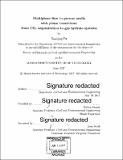Multiphase flow in porous media with phase transitions : from CO₂ sequestration to gas hydrate systems
Author(s)
Fu, Xiaojing, Ph. D. Massachusetts Institute of Technology
DownloadFull printable version (18.03Mb)
Other Contributors
Massachusetts Institute of Technology. Department of Civil and Environmental Engineering.
Advisor
Ruben Juanes.
Terms of use
Metadata
Show full item recordAbstract
Ongoing efforts to mitigate climate change include the understanding of natural and engineered processes that can impact the global carbon budget and the fate of greenhouse gases (GHG). Among engineered systems, one promising tool to reduce atmospheric emissions of anthropogenic carbon dioxide (CO₂) is geologic sequestration of CO₂ , which entails the injection of CO₂ into deep geologic formations, like saline aquifers, for long-term storage. Among natural contributors, methane hydrates, an ice-like substance commonly found in seafloor sediments and permafrost, hold large amounts of the world's mobile carbon and are subject to an increased risk of dissociation due to rising temperatures. The dissociation of methane hydrates releases methane gas-a more potent GHG than CO₂-and potentially contributes to a positive feedback in terms of climatic change. In this Thesis, we explore fundamental mechanisms controlling the physics of geologic CO₂ sequestration and natural gas hydrate systems, with an emphasis on the interplay between multiphase flow-the simultaneous motion of several fluid phases and phase transitions-the creation or destruction of fluid or solid phases due to thermodynamically driven reactions. We first study the fate of CO₂ in saline aquifers in the presence of CO₂ -brine-carbonate geochemical reactions. We use high-resolution simulations to examine the interplay between the density-driven convective mixing and the rock dissolution reactions. We find that dissolution of carbonate rock initiates in regions of locally high mixing, but that the geochemical reaction shuts down significantly earlier than shutdown of convective mixing. This early shutdown reflects the important role that chemical speciation plays in this hydrodynamics-reaction coupled process. We then study hydrodynamic and thermodynamic processes pertaining to a gas hydrate system under changing temperature and pressure conditions. The framework for our analysis is that of phase-field modeling of binary mixtures far from equilibrium, and show that: (1) the interplay between phase separation and hydrodynamic instability can arrest the Ostwald ripening process characteristic of nonflowing mixtures; (2) partial miscibility exerts a powerful control on the degree of viscous fingering in a gas-liquid system, whereby fluid dissolution hinders fingering while fluid exsolution enhances fingering. We employ this theoretical phase-field modeling approach to explain observations of bubble expansion coupled with gas dissolution and hydrate formation in controlled laboratory experiments. Unraveling this coupling informs our understanding of the fate of hydrate-crusted methane bubbles in the ocean water column and the migration of gas pockets in hydrate-bearing sediments.
Description
Thesis: Ph. D., Massachusetts Institute of Technology, Department of Civil and Environmental Engineering, 2017. Cataloged from PDF version of thesis. Includes bibliographical references (pages 159-175).
Date issued
2017Department
Massachusetts Institute of Technology. Department of Civil and Environmental EngineeringPublisher
Massachusetts Institute of Technology
Keywords
Civil and Environmental Engineering.